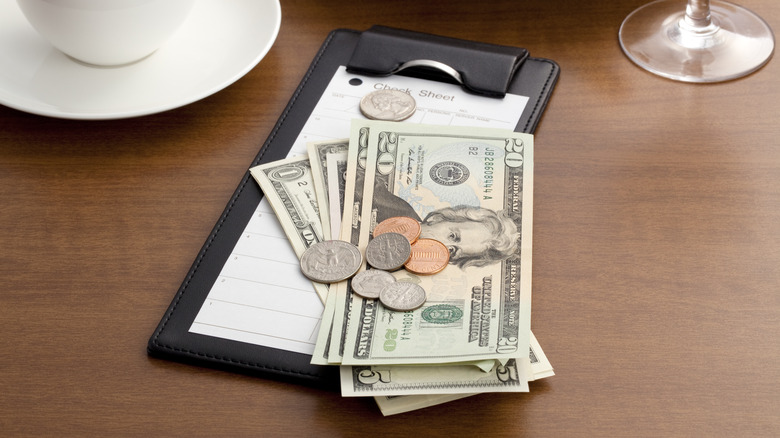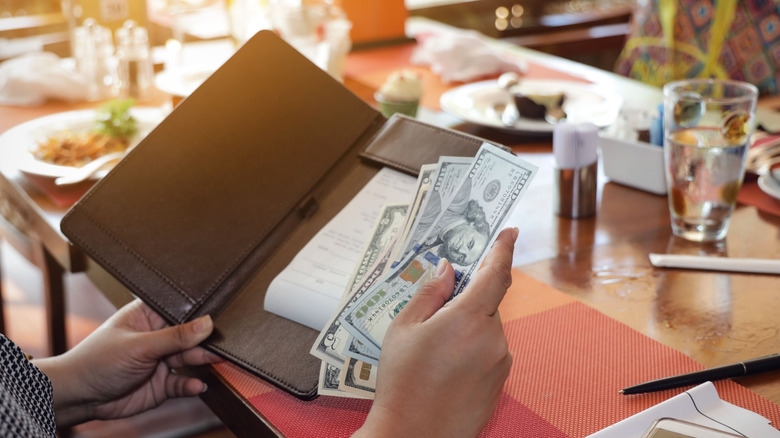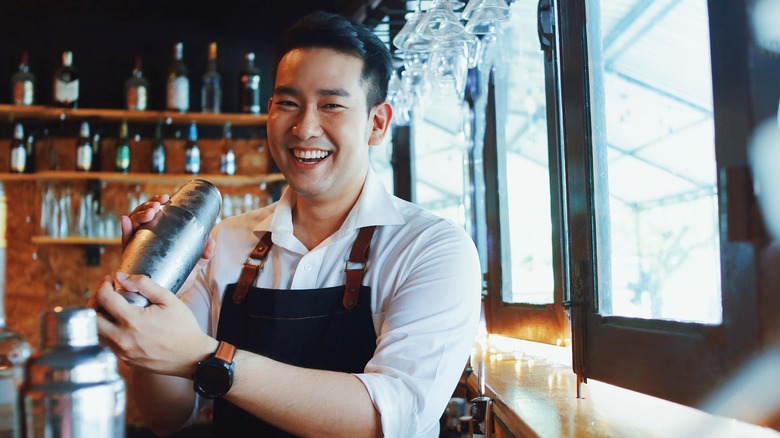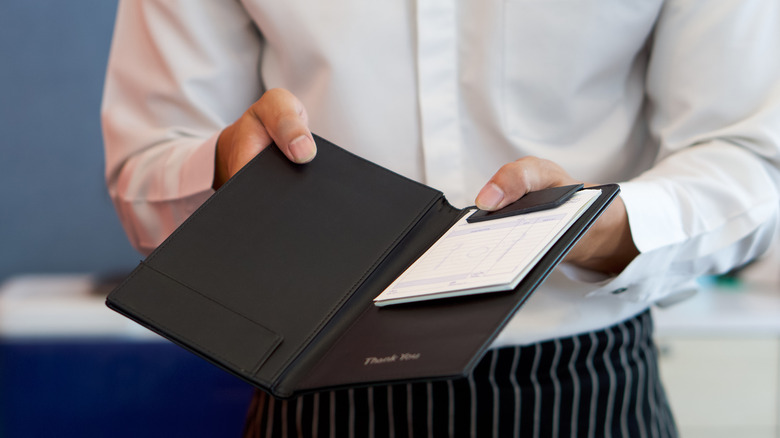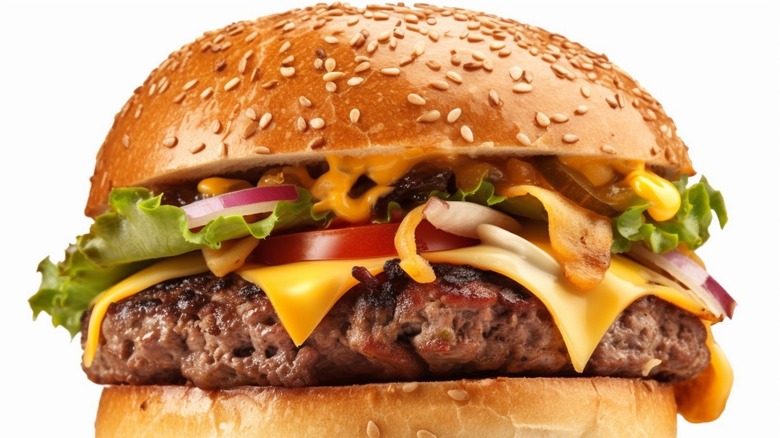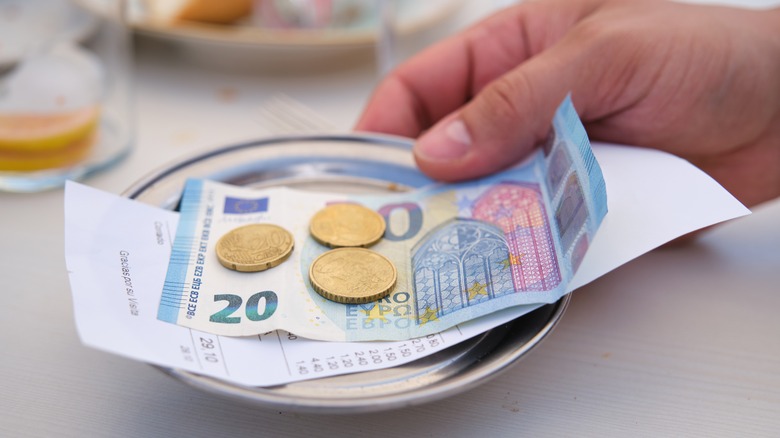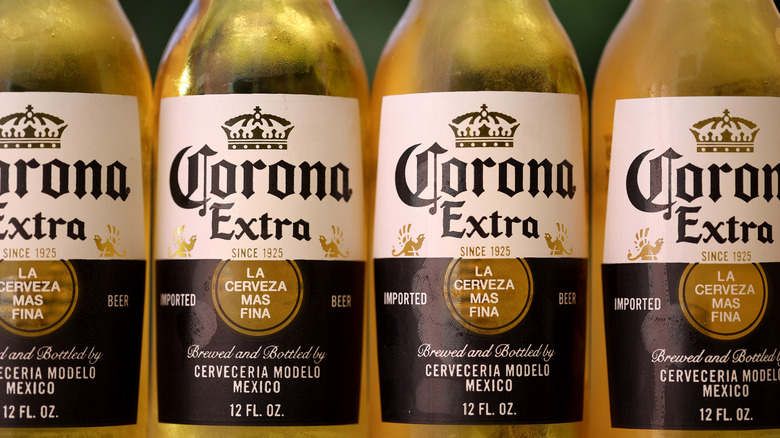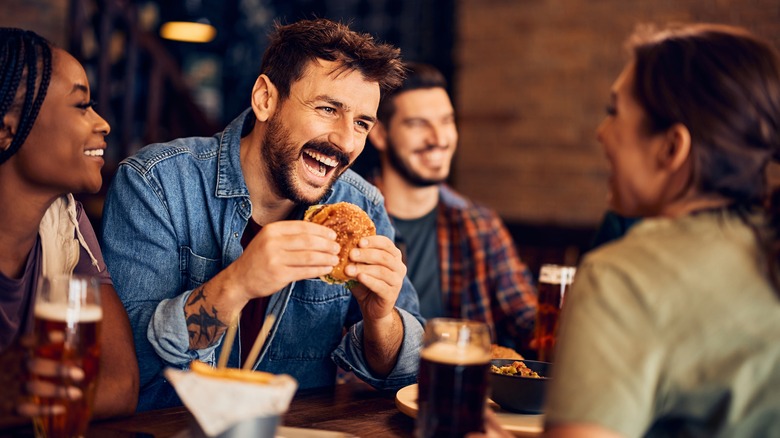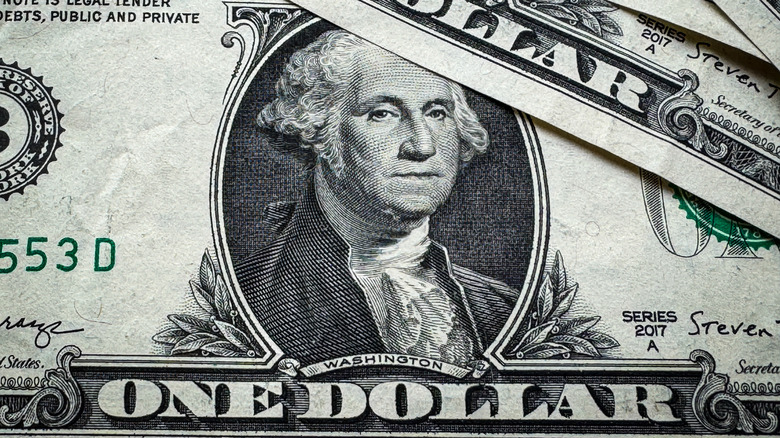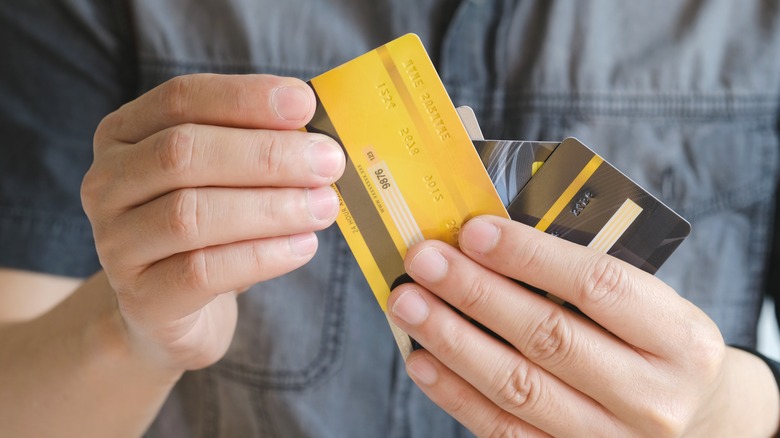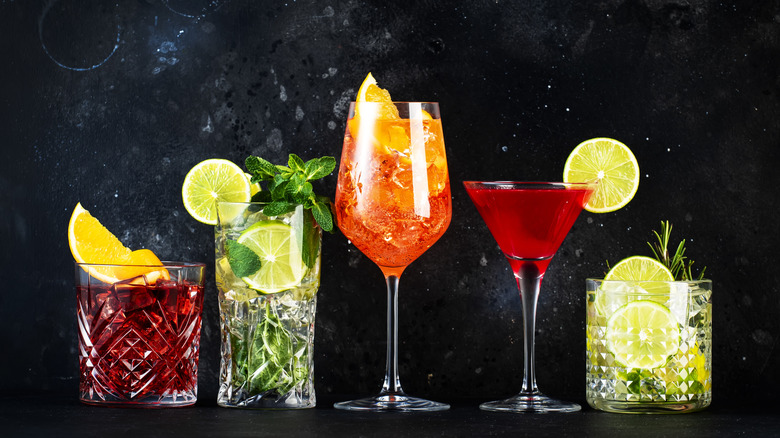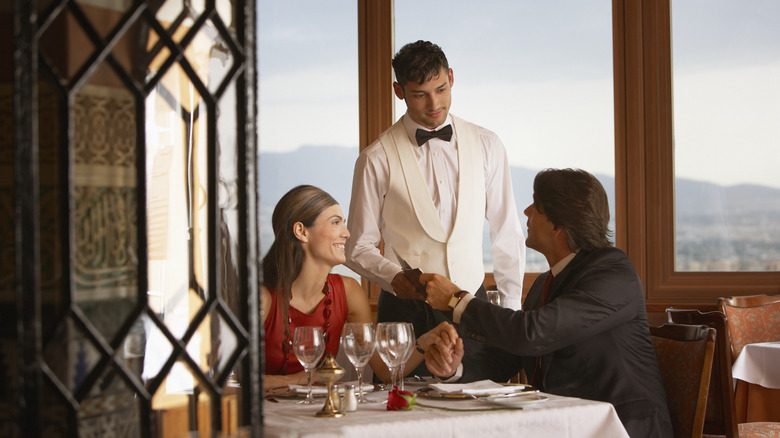12 Things To Keep In Mind When Tipping At Restaurants
Tipping is a controversial concept in the restaurant industry. When tipping made its way to North America in the 19th century, it did so as a replacement scheme for wages, perpetuated largely by post-Civil War white business owners who did not want to pay their Black workers, as explained in The New York Times. They transformed the tipping practice of European aristocrats — who paid tips in addition to a basic wage, however minuscule that might have been back in the day — into the only payment option available, effectively getting away with not paying their workers at all. Restaurant owners soon caught on, and the practice has endured to this day, where many restaurant servers still don't get paid minimum wage.
Although tipping in America continues to be widely seen as a way to incentivize a server to provide better service, or to show appreciation for exceptional work, the practice continues to have its detractors. Many restaurants have removed the option altogether, choosing instead to pay their servers a living wage, passing on the cost to the consumer through the bill. As such, it's important to know the tipping policy at the restaurant you chose for the evening, so you can act accordingly. Here's some help with navigating this whole affair, based on my personal experience as a server and tipper, and through extra research done.
The percentage rule
By and large, a restaurant tip in the United States is expected to be 15%, at the bare minimum, while 20% is also widely practiced. Anything in between is fair game, and you can always go over if you want, but not under. When you go out to a restaurant, it's important to budget not only for the food itself, but also the service, remembering that since your server is not getting paid by the restaurant, or hardly, their wages are up to you.
You may not agree with the idea of tipping. If you see it as exploitative and racially divisive, you wouldn't be alone. But withholding a tip is only going to hurt the person you're trying to stand up for. Until tipping is given the boot in our society as a whole, we're just going to have to stick with it. Resistance is futile. This has been particularly problematic since the COVID-19 pandemic, which caused tipping to decline by up to 16% since 2020, according to NBC affiliate Kxan. This is hardly surprising, given the extensive challenges faced by the restaurant industry in a post-pandemic world, but at the end of the day, let's remember that tips are supposed to reflect the performance of one particular server on a specific day, not displeasure with wider social trends over which they have no control.
Always round up
When dining out at a full-service restaurant, where your server comes to your table and brings you your order, it's important to remember that the person you interact with the most may be getting paid as little as $2.13 per hour, according to the U.S. Department of Labor, so if you could round up your bill before calculating the tip percentage, you'd be doing someone a solid — not out of the goodness of your heart, but because they're likely working hard and they deserve it. So for example, if your bill comes to $25, and it's easier to calculate 20% based on a round number like 20 or 30, make that $30 and go from there.
This practice is especially important when you're splitting the bill with someone. If that bill of $25 total becomes $10 and $10, instead of $15 and $15 when you're calculating your percentage, you're going to massively affect the amount of the tip. This is especially true if instead of $25 you actually spent $250 between the two of you. The higher the bill, the more work someone puts into making your experience worthwhile, even if most of it occurred behind the scenes. This work should be rewarded and reflected in the tip.
The bartender gets a tip, too
Bartenders might not have to run around a dining room as servers do on a busy night, but the smaller space in which they operate is not an indication of a smaller workload. Cocktails, for instance, can be especially labor intensive, some of them even rivaling entrées in complexity and skill level required for preparation. As such, it's just as much of a faux pas to forget to tip your bartender as it is to omit a tip for your server.
Nevertheless, it is clear that some rules differ between the bar and the dining room. Drinks are sometimes served one by one, instead of all in a single tab, while happy hour and other discounts are more the domain of the drinking world than the dining one. As such, it is widely accepted that you should leave a $1 tip for the bartender, at the very least. And if you run up a tab to rival any fancy restaurant bill, it's a safe bet to revert back to the 15% to 20% rule. The only exception is when you order drinks at your table — in most cases, your server will share their tip with the bartender at the end of their shift, so there is no need for you to tip them directly unless the spirit moves you.
Remember that tips might be included
Given the current controversy over tipping practices in restaurants, you might find that when you get your bill at a restaurant, the tip is already included. In these cases, by all means, you can refrain from including a tip — technically, you will do so simply by paying your bill, and it will likely be a decent one. And, as always, you can feel free to include an additional tip on top of that, as you see fit.
It helps to know what's going on, though. First of all, do pay attention to your bill — less scrupulous servers might not alert you to the fact that a tip is already included. But mostly, consider the pros and cons of this line item on your bill before you complain. Although many restaurants have had to rescind their no-tipping policy after patrons complained that they wanted to be in control of their tipping amounts, the practice helps equalize pay for demographics who might receive more or less money depending on their race, gender, or other factors rather than their performance on the job. But note that this is usually not the same thing as a service fee, which is a catch-all term to describe money that goes to the restaurant to cover credit card fees, health care for employees, or other charges that have nothing to do with your server.
Don't feel obligated to tip for fast-food
Staff at fast-food restaurants, cafes, or any place that requires diners to get up from their table to place their order and collect it, reside on a different plain than full-service restaurant servers, at least when it comes to tipping. First of all, they typically get paid a minimum wage. According to CNBC, a McDonald's employee can earn up to $17 per hour, compared to a restaurant server who might receive less than $3 per hour, all of which goes to taxes, leading them to survive on tips alone.
Second, even Shake Shack founder Danny Meyer, told CNBC that "if you're just taking out food, and it was just a transaction... I don't think there's any obligation to tip." Of course, we've all seen those tip jars at cafes and fast-food places. And with electronic payments, that tip jar has become a button on a tablet, so don't feel like you can't tip at all. No one is going to say no to extra money, given for a good reason. But, equally, if you can't or don't want to tip, don't feel bad. The work that has gone into the preparation of your meal in these cases has been carried out by someone who gets paid for their trouble.
The rules are different in other countries
The United States may be one of the only countries in the world that pays their servers next to nothing. Many are aware of the low salaries meted out in the business, and pay tips accordingly. But the situation in other countries is very different. In most places, as is only fair, servers are paid by their employers, and not according to the mercy of generous, or dutiful, strangers.
For instance, tips are expected in Mexico, especially from Americans, as the practice in the United States is well-known in surrounding countries. But the 15% to 20% rule goes out the window here in favor of a standard of 10% of the bill — which is definitely easier on the wallet. You may find this to be true in many other countries, as well, including all across Europe. In many cases, tipping there isn't even expected at all, and many locals don't bother with it. They rightly assume that their servers are already being paid for their work. Just know that this rule may differ slightly for touristy areas — Americans abroad have been tipping for years, and restaurants in highly trafficked areas know this and may expect a continuation of this behavior.
Tip even when drinks are free
The rule for tipping amounts is largely based on the final bill: A $40 bill should garner an $8 tip, for instance. But that rule still holds even if the bill is precisely $0. That is, even when you are served complimentary drinks, such as cocktails at a casino, the person bringing you those libations is still working hard. So even if the establishment you're frequenting has decided to comp your drinks or reduce the price of the product, the labor still needs to be recognized.
A good rule of thumb for buy-1-get-1-free deals is to tip for both drinks, even the free one, as your bartender has put in the effort to serve both to you. For a discounted drink, it's best to tip based on the pre-discount price if you know it or over-tip slightly if you don't. After all, if you're getting your drinks for free or at a discount, you should have more disposable income to dedicate to a worker who deserves the added bonus. And if you're in a location that is handing out a lot of discounted drinks, chances are that there will be a fair amount of drunk people around — people your server is going to have to deal with and clean up after.
In big groups, watch out for shirkers
Large groups of diners tend to eat and drink merrily, sometimes forgetting themselves — and their manners. This may be one reason why many restaurants automatically apply a gratuity fee of 18% or higher on parties of six people or more. It forces the group to make good on their bill, and their tip, regardless of whether anyone is trying to shirk their financial responsibilities. This move is designed to protect the server who fulfilled their role.
But if you're in that group of potential tip shirkers, you may have to be on the alert. We've all heard stories of that one friend who just paid for their dish, at the price listed on the menu, without considering tax or tip, hoping that his parsimoniousness would get lost in the fray at settling time. Or the one who paid even less than they owed for their meal because they knew no one was paying attention. Well, for the sake of your server, it's time to pay attention. Calling out a friend in a jokey way might do the trick, and if not, giving a slightly bigger tip on your end should set the record straight.
Tip with actual money
Every once in a while, a story will come out about some amazing, outlandish tip a server was given. The tip this Massachusetts server received, for instance, led to $2,000 in cash after the lottery ticket she received won. But that ticket could have just as easily come up blank, in which case she would have received absolutely nothing.
This is why it is widely recommended that tips only be doled out in the form of actual money, whether it be cash or those numbers on a screen that represent hard currency. Even more egregious was the time a Cracker Barrel waitress got a "tip" from an elderly couple in the form of a letter, which stated that "the woman's place is in the home," as reported by NBC. If we have to explain why that's wrong, we can't help you. Possibly the only exception to this rule is casino chips, which can be turned in for cash anyway, so perhaps that's not an exception at all.
Tip by credit card if you can
For years, servers across the country have preferred receiving tips in cash. A cash tip meant not having to declare it on a tax form, thereby lowering a person's tax bill at the end of the year. Although a questionable practice as far as the IRS is concerned, this helped many people in the precarious restaurant business get by.
Then came the COVID-19 pandemic. Requests for unemployment payments skyrocketed, and former servers were finding themselves having to accept such payments based on previously declared income, which was lower than what they actually got when accounting for cash tips. But when a server is tipped by a credit card, the amount automatically counts as part of that server's income, which may raise taxes in the short term, but can help if that person ever needs to rely on unemployment benefits, which only reflect the official salary. Having a paper trail for tips, therefore, can help a person with all the perks that come with a higher salary — in addition to unemployment, they may be able to get credit cards approved more easily, not to mention mortgages if they want to buy a house.
Tip more for cocktails
When you go to the mechanic to get your car fixed, they'll typically give you a quote that includes both parts and labor — the cost of replacement parts needed for your car, plus the labor needed to install them. An expensive part may require cheap labor, while a cheap part might call for long hours of work. A similar thing is going on when you order drinks at the bar. An expensive craft beer may cost you a pretty penny, but it only takes the bartender a flick of the wrist to open the bottle for you. Conversely, a complicated cocktail may require few ingredients but fancy footwork, in which case your bartender is sweating it out for you, spending some time on the process.
As such, it's generally advised that we tip bartenders according to whether they served beer or cocktails, and not necessarily just for the cost of the tab. That is, if you order beer or wine, don't feel bad if you only leave a few bucks behind. But if you order a fancy cocktail, you're going to need to shell out on the tip. The only exception here is if you're delving into the world of craft beers and fine wines. Your bartender may spend some time going over tannins, mouth feel, or hints of cherry with you, or pouring you small samples of a local brew. In these cases, upping the tip amount might be the right thing to do.
Consider tipping even when the service is bad
The core idea of a tip is that it should be a reward for a job well done. The amount should reflect a patron's level of satisfaction with a particular server, varying slightly according to how happy one is. But what happens when a server is just plain bad? And that is not referring to factors the server can't control — such as staffing levels at the restaurant or quality of the food. This means a server's attitude or overall ability to get the job done.
In cases of truly bad service, many have contemplated the idea of not tipping at all. Why pay someone when they didn't provide what they were there to fulfill? Indeed, a recent survey found that one of the main reasons people don't tip at restaurants is because they are dissatisfied with their server due to rude behavior or unsanitary practices. If that happens to you, we wouldn't judge if you decided to not leave a tip. If someone goes out of their way to be impolite or unsanitary, it's not going to be good for anyone. But if the reason was just a wrong order or slow service, it might be worth tipping anyway. You never know what the cause of the slow service might be, while a wrong order could happen to anyone, especially on a busy night.
